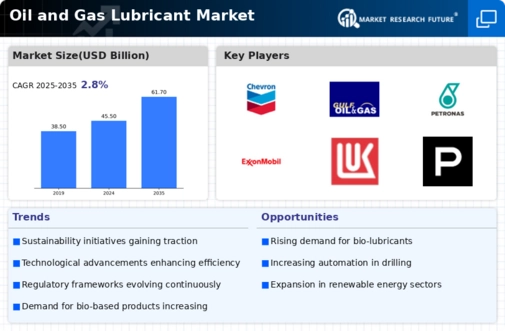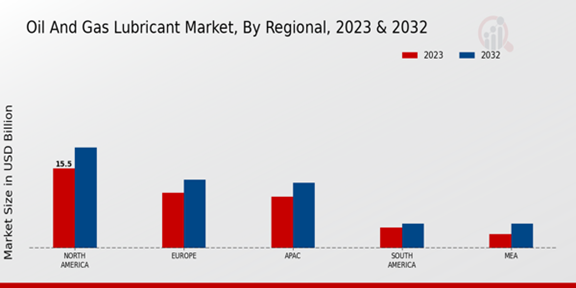Market Growth Projections
The Global Oil and Gas Lubricant Market Industry is projected to experience robust growth in the coming years. With a market value of 45.5 USD Billion in 2024, it is expected to reach 61.7 USD Billion by 2035. This growth trajectory indicates a compound annual growth rate of 2.81% from 2025 to 2035. The increasing demand for high-performance lubricants, driven by technological advancements and the expansion of the oil and gas sector, underscores the industry's potential. As companies seek to enhance operational efficiency and comply with environmental regulations, the market is poised for sustained growth.
Growth of the Oil and Gas Sector
The growth of the oil and gas sector serves as a fundamental driver for the Global Oil and Gas Lubricant Market Industry. As exploration and production activities expand, the demand for high-quality lubricants that can withstand extreme conditions increases. Regions with significant oil reserves, such as the Middle East and North America, are witnessing substantial investments in infrastructure and technology. This expansion is expected to propel the market, with a projected compound annual growth rate of 2.81% from 2025 to 2035. The increasing complexity of extraction processes necessitates the use of specialized lubricants, further fueling market demand.
Rising Demand for Energy Efficiency
The Global Oil and Gas Lubricant Market Industry experiences a notable increase in demand for energy-efficient solutions. As companies strive to optimize operations and reduce costs, the focus on lubricants that enhance equipment performance becomes paramount. For instance, advanced synthetic lubricants are gaining traction due to their superior thermal stability and reduced friction properties. This trend is expected to contribute to the market's growth, with projections indicating a market value of 45.5 USD Billion in 2024. The emphasis on sustainability and energy efficiency aligns with global initiatives to minimize environmental impact, further driving the adoption of innovative lubricant solutions.
Increased Focus on Equipment Reliability
The Global Oil and Gas Lubricant Market Industry is witnessing an increased focus on equipment reliability and operational efficiency. Companies are recognizing the importance of maintaining equipment to prevent costly downtimes and enhance productivity. High-performance lubricants that provide superior protection against wear and tear are becoming essential in this context. For instance, the adoption of condition monitoring technologies allows operators to optimize lubricant usage and extend service intervals. This trend is likely to drive market growth, as organizations prioritize investments in lubricants that ensure the reliability and longevity of critical equipment in oil and gas operations.
Regulatory Compliance and Environmental Standards
The Global Oil and Gas Lubricant Market Industry is significantly influenced by stringent regulatory compliance and environmental standards. Governments worldwide are implementing regulations aimed at reducing emissions and promoting the use of eco-friendly lubricants. This regulatory landscape compels companies to adopt lubricants that meet these standards, thereby driving innovation in formulation and application. For instance, the European Union's REACH regulations have prompted manufacturers to develop lubricants with lower environmental impact. Consequently, this trend is likely to bolster market growth, as companies prioritize compliance while seeking high-performance lubricants that align with sustainability goals.
Technological Advancements in Lubricant Formulations
Technological advancements play a crucial role in shaping the Global Oil and Gas Lubricant Market Industry. The development of high-performance lubricants, such as bio-based and synthetic options, has revolutionized the sector. These formulations offer enhanced protection against wear and corrosion, thereby extending equipment life and reducing maintenance costs. For example, the introduction of nanotechnology in lubricant formulations has shown promising results in improving performance metrics. As a result, the market is anticipated to grow, reaching 61.7 USD Billion by 2035, driven by the continuous evolution of lubricant technologies that meet the demands of modern oil and gas operations.















